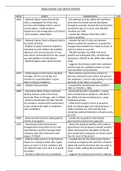TRADE UNIONS’ CIVIL RIGHTS TIMELINE
DATE EVENT SIGNIFICANCE G/B
1866 - National Labour Union formed (by - first attempt at unity within the workforce,
Sylvis, campaigned for 8 hour day, aims were too broad and not developed
currency and banking reform, end of enough to succeed, showed the lack of clarity
convict labour, a federal labour around the idea of a union, only 300,000
department and immigration restrictions) members by 1968
- Iron Founders strike failed - caused the collapse of the NLU, didn’t
achieve anything
1869 - National Labour Union collapsed (due to - showed the lack of unity and extreme
the death of Sylvis) divisions within the workforce, revealed the
- Knights of Labor formed by Stephens changes that needed to be made to unions in
(intended to unite skilled and unskilled order for them to succeed
labourers and remove barriers of race - 700,000 members by 1886, had more
and culture, demanded 8 hour day, equal specific and achievable aims, membership
pay and abolition of child labour) declined to 100,000 in the 1890s after violent
- National Negro Labor Union formed strike
- suggests the divisions within the workforce
and the need for unskilled workers to have
representation and protection
1873 - Molly Maguires (Irish miners derailed - their violence caused many workers to
carriages, set fire to coal tips and become reluctant to join unions and proved
murdered a superintendent to gain the employers’ concern about giving in to the
better working conditions) demands of the labour movement
1885 - Wabash Railroad strike - boosted KOL membership from 20,000 in
1881 to 700,000 in 1886
1886 - Haymarket Affair (violence between - destroyed the KOL’s reputation, causing
striking workers at the McCormick their membership to decline to 100,000 in
Harvester Plant in Chicago, with 11 killed) the 1890s and internal divisions to create
- American Federation of Labor formed breakaway groups
(by Gompers, worked with businessmen - reflects the change in focus to practical
to give workers the right to mediation goals of raising wages and reducing hours, 2
and conciliation) million members by 1914 and the only
remaining national federation of trade unions
by 1924
1890 - Sherman Anti-Trust Act (attempted to - reveals the exception to the federal
restrict monopolies) government’s laissez-faire approach
1892 - Homestead Strike (between the - shows the absolute hostility of the federal
Amalgamated Association of Iron and government and employers towards workers’
Steel Workers and the Carnegie Steel rights, destroyed the reputation of the AA
Company after they refused to raise and caused steel companies to remain union-
wages, 27 killed) free for most of the period
1894 - Pullman Strike (porters at the Pullman - revealed how far the federal government
Palace Car Company strike after wages would go to suppress the assertion of labour
were cut and 1/3 of the workforce laid rights and was the first time law was used to
off, federal troops were sent in to break break a strike, setting the precedent until
the strike) 1932
- Omnibus Indictment Act (prohibited - suggests the federal government’s attitude,





